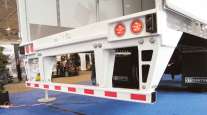Senior Reporter
ATA Reaffirms Opposition to Side Underride Guard Legislation

[Stay on top of transportation news: Get TTNews in your inbox.]
Legislation that would require the installation of side underride guards on heavy trucks is not based on sufficient science, data or demonstrated overall effectiveness, American Trucking Associations wrote to congressional transportation leaders.
The federation’s position was also recently disclosed July 11 in the online blogging platform Medium.
The letter, sent only a few days after a House Subcommittee on Highways and Transit hearing last month on the state of trucking, was written as follow-up of testimony given in opposition by ATA President Chris Spear and supporters of the Stop Underrides Act of 2019.
ATA Stop Underrides Act Letter by Transport Topics on Scribd
The bill, introduced earlier this year in the House (H.R.1511) and Senate (S.665), calls for the mandatory installation of side underride guards as well as strengthening rear underride guards that could help stop a car from going underneath a heavy truck in a crash.
However, equipping an estimated 12 million trailers with a side underride guard would cost approximately $2,900 each, including shipping, which would equate to approximately $34.8 billion spent on underride guards industrywide, according to ATA.

Horvath
“That staggering figure would result in what is likely the largest unfunded mandate on a private sector industry in U.S. history,” said the letter, written June 19 and signed by Daniel Horvath, ATA’s vice president of safety policy. “Furthermore, when combined, the expected cost of labor in installing these guards would exceed the industry’s annual net revenue, essentially putting trucking out of business, and grinding our economy to a screeching halt.”
The dangers of a passenger car striking the side of a commercial motor vehicle can be catastrophic, truck safety advocate Andy Young said in a written statement to accompany his testimony at the hearing June 12.
“The shipper and broker should not, and must not, be allowed to hire a cheaper, less safe truck company, simply for the sake of transporting goods at the cheapest freight rates possible,” Young wrote.
But ATA said, “The Stop Underrides Act also fails to consider numerous complicating factors such as engineering trade-offs involving weight, strength, and effectiveness of side guards. This is not an issue of the added weight to the trailer requiring companies to transport less freight, but rather serious concerns for the potential to degrade the structural ability of a trailer over time.”
The ATA letter highlighted a yearlong investigation by the Government Accountability Office, made public in March, that concluded more study should be conducted by the Department of Transportation on the underride guard issue.
“ATA agrees with GAO’s findings and recommendation for additional research on side underride guards,” the ATA letter said. “Our industry’s unwavering commitment to safety should not be impeded by hastily mandating a technology that government experts report requires greater study.”

Rader
Russ Rader, a spokesman for the Insurance Institute for Highway Safety, said testing done by his organization shows that side underride guards would save lives.
“We have not done as much research into side underride protection as we have rear underride guards,” Rader told Transport Topics. “But we have done side guard tests at 35 and 40 mph. Our tests clearly show that side guards would have benefits.”
For instance, in 2017, the latest numbers available, there were 398 fatalities in crashes with the rear of trucks and 377 fatalities in crashes with the side of trucks, according to the institute.
Horvath said, “Even though this is something that’s tragic, we want to make sure that we handle this appropriately. There’s a lot of unknowns out there that we need to address before we continue forward with it.”
He said that trucking spends $10 billion annually in safety investments.
“We feel that if this were to pass, it would divert money that’s spent currently on safety technologies to really what is an unproven technology,” Horvath said.



